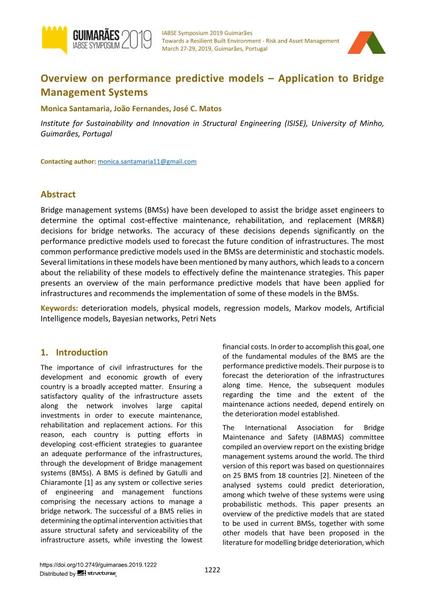Overview on performance predictive models – Application to Bridge Management Systems

|
|
|||||||||||
Bibliografische Angaben
| Autor(en): |
Monica Santamaria
(Institute for Sustainability and Innovation in Structural Engineering (ISISE), University of Minho, Guimarães, Portugal)
João Fernandes (Institute for Sustainability and Innovation in Structural Engineering (ISISE), University of Minho, Guimarães, Portugal) José Campos e Matos (Institute for Sustainability and Innovation in Structural Engineering (ISISE), University of Minho, Guimarães, Portugal) |
||||
|---|---|---|---|---|---|
| Medium: | Tagungsbeitrag | ||||
| Sprache(n): | Englisch | ||||
| Tagung: | IABSE Symposium: Towards a Resilient Built Environment Risk and Asset Management, Guimarães, Portugal, 27-29 March 2019 | ||||
| Veröffentlicht in: | IABSE Symposium Guimarães 2019 | ||||
|
|||||
| Seite(n): | 1222-1229 | ||||
| Anzahl der Seiten (im PDF): | 8 | ||||
| DOI: | 10.2749/guimaraes.2019.1222 | ||||
| Abstrakt: |
Bridge management systems (BMSs) have been developed to assist the bridge asset engineers to determine the optimal cost-effective maintenance, rehabilitation, and replacement (MR&R) decisions for bridge networks. The accuracy of these decisions depends significantly on the performance predictive models used to forecast the future condition of infrastructures. The most common performance predictive models used in the BMSs are deterministic and stochastic models. Several limitations in these models have been mentioned by many authors, which leads to a concern about the reliability of these models to effectively define the maintenance strategies. This paper presents an overview of the main performance predictive models that have been applied for infrastructures and recommends the implementation of some of these models in the BMSs. |
||||
